Research - (2020) Advances in Dental Surgery
Dermatoglyphics in Dentistry a Study on Knowledge About Importance of Dermatoglyphics among First Year Dental Students
Yoshita Guntupalli1, Keerthi Sasanka L1*, Karthik Ganesh Mohanraj2 and Dhanraj Ganapathy1
*Correspondence: Keerthi Sasanka L, Department of Pedodontics and Preventive Dentistry, Saveetha Dental College, Saveetha Institute of Medical and Technical Sciences, Saveetha University, Chennai, India, Email:
Abstract
Dermatoglyphics is an important screening test which can be used in the early diagnosis of many diseases including dental diseases. It is the study of dermal ridges and patterns. Selected patterns indicate the presence or occurrence of certain diseases. Fingerprints are present on every individual and hence availability is not a problem. If sufficient knowledge is inculcated, many diseases can be cured in early stages. In the present study, a self prepared questionnaire comprising 10 questions was prepared and circulated among the participants on an online basis. The results were collected and the knowledge and awareness levels of the students were hence analysed. It was found that 79.8% of students had heard of dermatoglyphics previously but only 32.7% knew it was the study of dermal patterns and ridges. Not many were aware of the uses and purpose of dermatoglyphics and its use in dentistry. The awareness levels among the dental students were poor. Measures should be taken to spread knowledge and awareness about this important diagnostic tool and its effective use in treating diseases.
Keywords
Dermatoglyphics, Dermal ridges, Fingerprints, Dental diseases, Treatment, Awareness
Introduction
Dermatoglyphics is the study of dermal ridges configurations. It is a branch of physical anthropology, medicine as well as genetics [1]. Fingerprint patterns have the same origin as facial structures and are influenced by both hereditary and environmental factors [2]. It is the best available diagnostic tool for many diseases [3]. It is an age old study, the first study dating back to as early as 1684 [4]. The term dermatoglyphics is derived from the greek words ‘derma’ meaning skin and ‘glyphics’ meaning carving [5,6]
Dermatoglyphic studies can be done in two ways namely- quantitative analysis and qualitative analysis. Qualitative analysis includes Total Finger Ridge Count (TRFC), Absolute Finger Ridge Count (AFRC), AB ridge count, ATD angle. Quantitative analysis includes analysis of fingerprint patterns of right and left hand separately, right and left hand combined, abnormal palmer creases, sydney line, simian line and fluctuating asymmetry [7]. The various dermatoglyphic landmarks are- the curved lines in a fingerprint constituting ridges [8]. The approximate centre of the pattern is known as core. The meeting point of three ridges that forms approximately 120 degrees with one another is known as triradial point or beeta [9].
Skin is the largest human organ. The ectodermal layers of the skin found on the pam with intricate lines, being stable throughout life, have grabbed scientific attention [10]. Any disturbances during their formation might possibly have the likelihood of a person developing malocclusion and other dental diseases [11]. It has been shown that oral cancer, bruxism, dental caries, dental fluorosis, and many other dental diseases show characteristic dermatoglyphic patterns [12,13].
Dermatoglyphic studies continue to go on without any definite results. Not many dental students know about dermatoglyphics and its usefulness in diagnosing dental diseases. This study aims to test the knowledge as well as spread awareness about dermatoglyphics among 1st year dental students.
Materials and Methods
This study was carried out on an online setting among South Indian dental students. Approval was received from the Institutional Review Board (SRB-SDC). The number of people involved in this study are two,i.e., the primary investigator and guide. A well-structured questionnaire comprising 10 questions covering the sociodemographic information, knowledge, attitude, and perception was framed and administered to the participants through online google forms. The sample size of 104 participants were selected via simple random sampling. The results were then obtained and analysed. The statistical software used was SPSS version 22. The statistical test was Descriptive statistics.
Results and Discussion
Results were collected and the data was analysed. It was found that not many students had a complete knowledge about dermatoglyphics.
From Figure 1, we see that 79.8% of the students had heard of dermatoglyphics before while 20.2% have not. Dermatoglyphics deals with the study of fine patterned volar surfaces of soles, palms [14,15]. When asked what dermatoglyphics is, 67.3% students answered incorrectly. Only 32.7% answered correctly (Figure 2). Like clinical history, examination, and investigations, dermatoglyphics will play an important role in revealing genetic susceptibility to many diseases, thus acting as an effective screening test [7,16]. In Figure 3 74% were aware about dermatoglyphics being an effective screening test, while 26% were not aware. Most dermatoglyphics are correlated with genetic abnormalities [14]. When asked whether genetic abnormalities will be reflected in dermatoglyphic patterns, from Figure 4, we see that 64.4% answered yes, which is the correct answer, while 35.6% answered incorrectly with no.
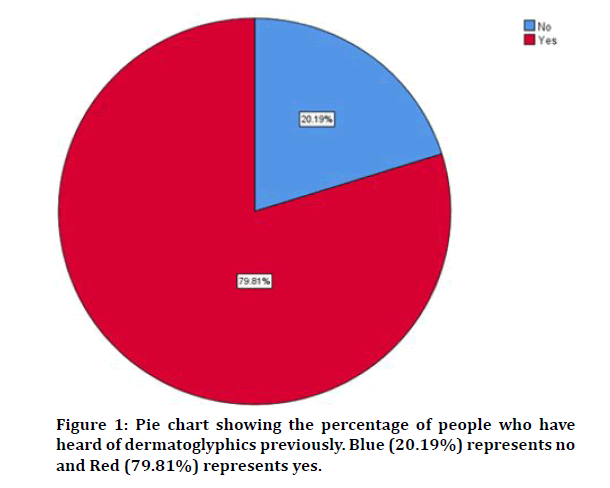
Figure 1: Pie chart showing the percentage of people who have heard of dermatoglyphics previously. Blue (20.19%) represents no and Red (79.81%) represents yes.
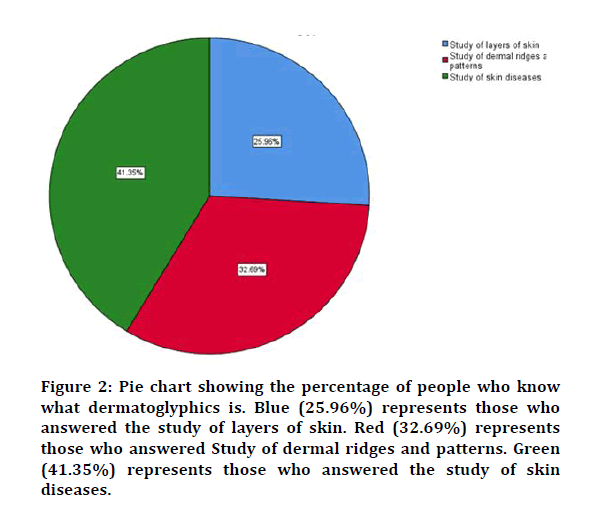
Figure 2: Pie chart showing the percentage of people who know what dermatoglyphics is. Blue (25.96%) represents those who answered the study of layers of skin. Red (32.69%) represents those who answered Study of dermal ridges and patterns. Green (41.35%) represents those who answered the study of skin diseases.
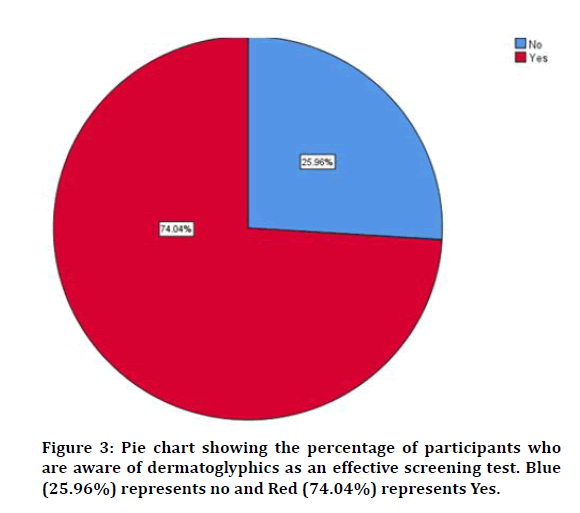
Figure 3: Pie chart showing the percentage of participants who are aware of dermatoglyphics as an effective screening test. Blue (25.96%) represents no and Red (74.04%) represents Yes.
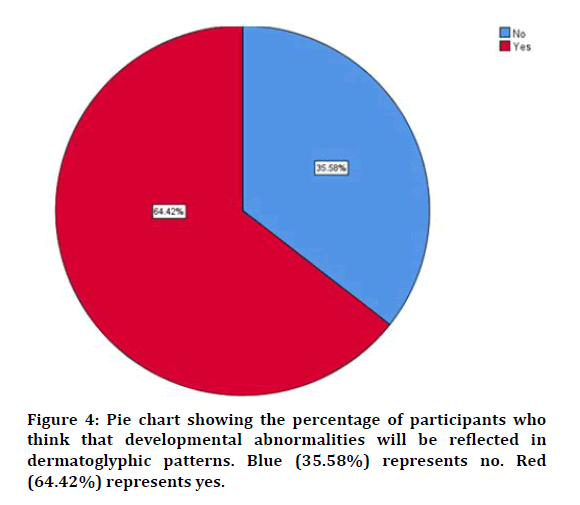
Figure 4: Pie chart showing the percentage of participants who think that developmental abnormalities will be reflected in dermatoglyphic patterns. Blue (35.58%) represents no. Red (64.42%) represents yes.
Fingerprints are unique for every individual and unalterable, making it an excellent tool for population studies [9]. According to Figure 5, 64.4% said that dermatoglyphic patterns of two individuals can be similar, which is incorrect. 35.6% answered correctly, saying they are unique and cannot be similar. Fingerprint determination is genetic. However, it is also affected by the environment in the first trimester of pregnancy [17,18]. A combination of hereditary (genetic) and environmental factors can lead to appearance of abnormalities as reflected in dermatoglyphics [19,20]. In Figure 6, 37.5% answered correctly stating that it is influenced by both genetic and environmental factors, while 23.1% answered it is influenced only by genetic factors and 39.4% said it is affected by environmental factors alone. When asked whether dermatoglyphics can affect personality traits, from Figure 7, 61.5% answered incorrectly saying yes while 38.5% answered correctly with a no.
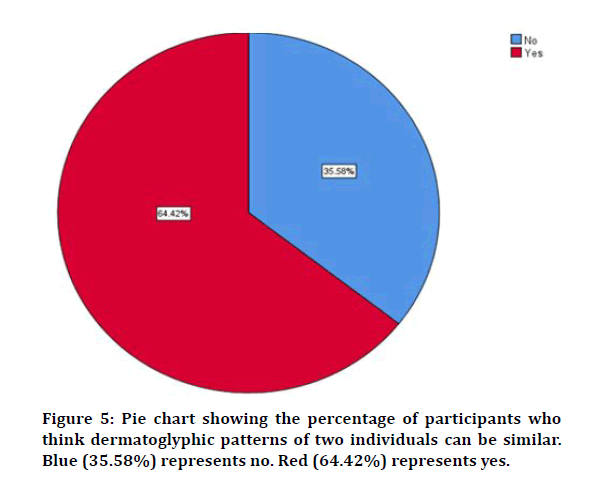
Figure 5: Pie chart showing the percentage of participants who think dermatoglyphic patterns of two individuals can be similar. Blue (35.58%) represents no. Red (64.42%) represents yes.
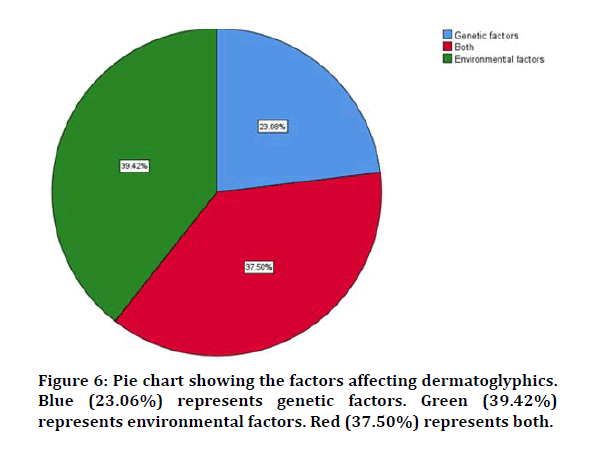
Figure 6: Pie chart showing the factors affecting dermatoglyphics. Blue (23.06%) represents genetic factors. Green (39.42%) represents environmental factors. Red (37.50%) represents both.
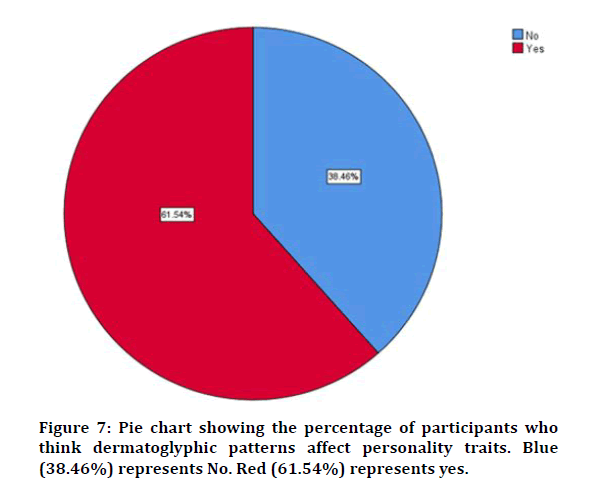
Figure 7: Pie chart showing the percentage of participants who think dermatoglyphic patterns affect personality traits. Blue (38.46%) represents No. Red (61.54%) represents yes.
Extraction of data has revealed a positive correlation between dermatoglyphics and orofacial disorders [21]. Hence dermatoglyphics can be used as a predictive model to diagnose orofacial conditions [14,22]. 59.6% were aware that dermatoglyphics can be used to screen dental diseases, while 40.4% answered incorrectly stating that it cannot be used in dental diseases (Figure 8). Oral diseases such as oral cancer, bruxism, dental caries, dental fluorosis can be diagnosed using dermatoglyphics. Patterns can be correlated with periodontitis [23,24]. In Figure 9, 32.7% answered correctly and stated that oral cancer, malocclusion, periodontitis, and dental caries can be diagnosed using dermatoglyphics. When asked to self-assess their knowledge on dermatoglyphics, from Figure 10 we see that 16.3% assessed themselves as excellent, 38.5% thought that their knowledge was good, 35.6% rated themselves as average, 9.6% thought they had poor knowledge. Figure 11-17 shoes the different correlations.
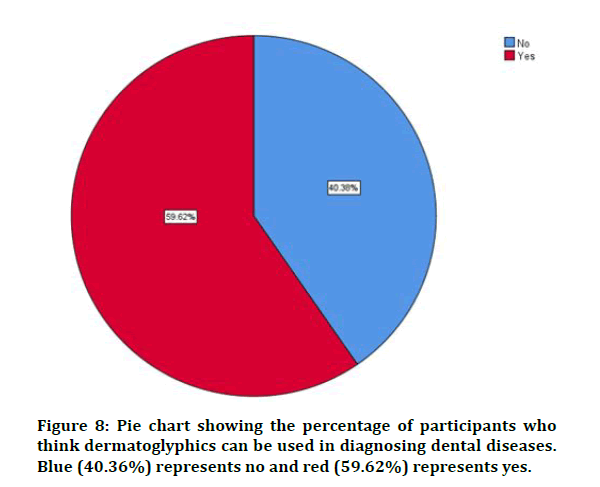
Figure 8: Pie chart showing the percentage of participants who think dermatoglyphics can be used in diagnosing dental diseases. Blue (40.36%) represents no and red (59.62%) represents yes.
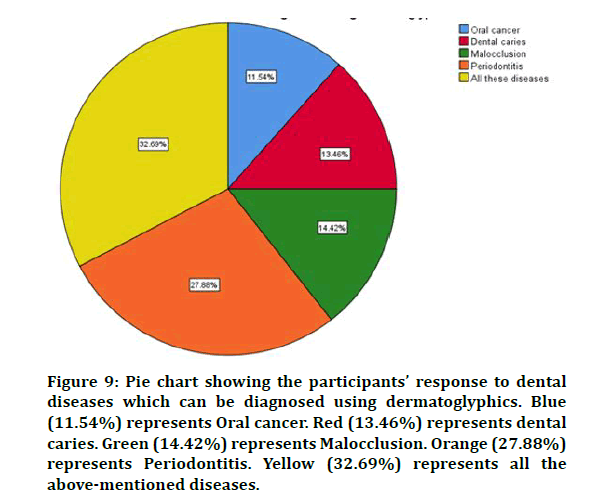
Figure 9: Pie chart showing the participants’ response to dental diseases which can be diagnosed using dermatoglyphics. Blue (11.54%) represents Oral cancer. Red (13.46%) represents dental caries. Green (14.42%) represents Malocclusion. Orange (27.88%) represents Periodontitis. Yellow (32.69%) represents all the above-mentioned diseases.
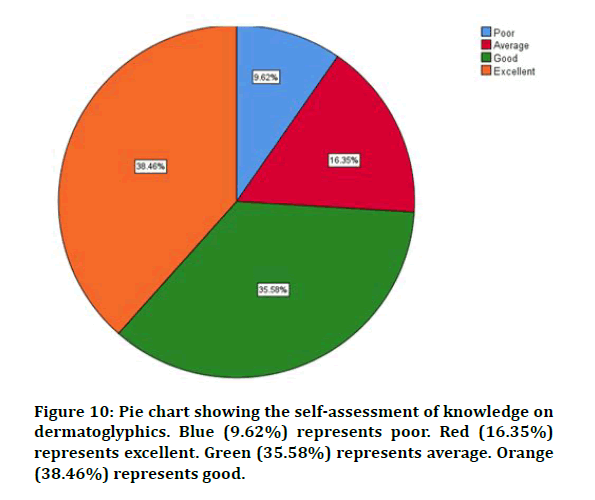
Figure 10: Pie chart showing the self-assessment of knowledge on dermatoglyphics. Blue (9.62%) represents poor. Red (16.35%) represents excellent. Green (35.58%) represents average. Orange (38.46%) represents good.
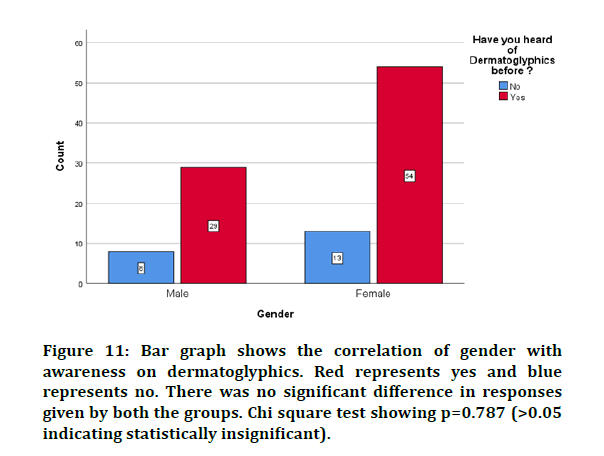
Figure 11: Bar graph shows the correlation of gender with awareness on dermatoglyphics. Red represents yes and blue represents no. There was no significant difference in responses given by both the groups. Chi square test showing p=0.787 (>0.05 indicating statistically insignificant).
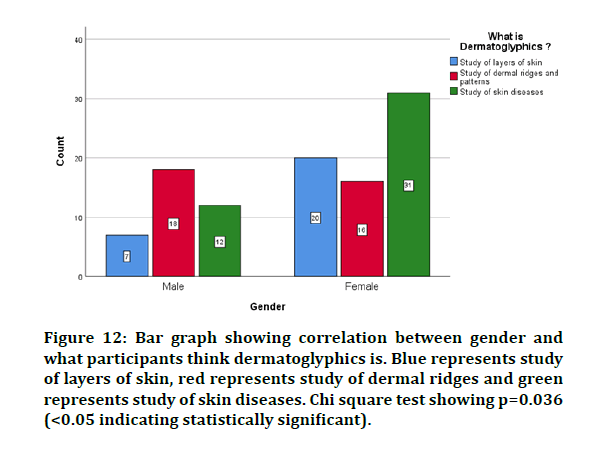
Figure 12: Bar graph showing correlation between gender and what participants think dermatoglyphics is. Blue represents study of layers of skin, red represents study of dermal ridges and green represents study of skin diseases. Chi square test showing p=0.036 (<0.05 indicating statistically significant).
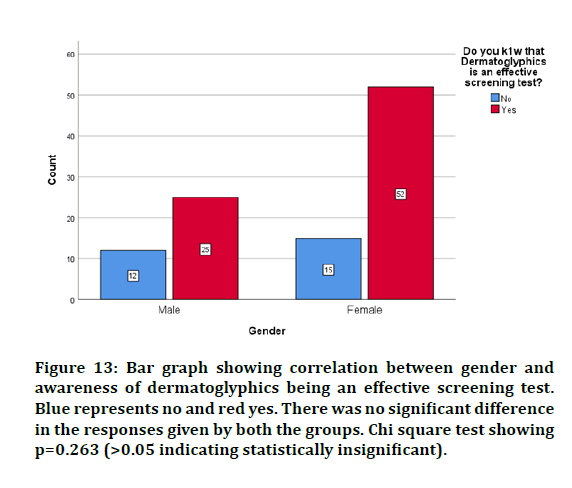
Figure 13: Bar graph showing correlation between gender and awareness of dermatoglyphics being an effective screening test. Blue represents no and red yes. There was no significant difference in the responses given by both the groups. Chi square test showing p=0.263 (>0.05 indicating statistically insignificant).
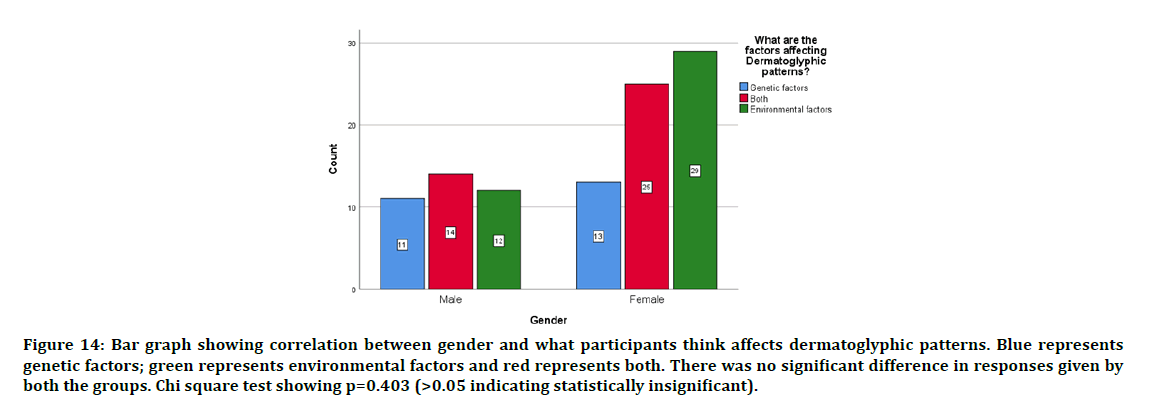
Figure 14: Bar graph showing correlation between gender and what participants think affects dermatoglyphic patterns. Blue represents genetic factors; green represents environmental factors and red represents both. There was no significant difference in responses given by both the groups. Chi square test showing p=0.403 (>0.05 indicating statistically insignificant).
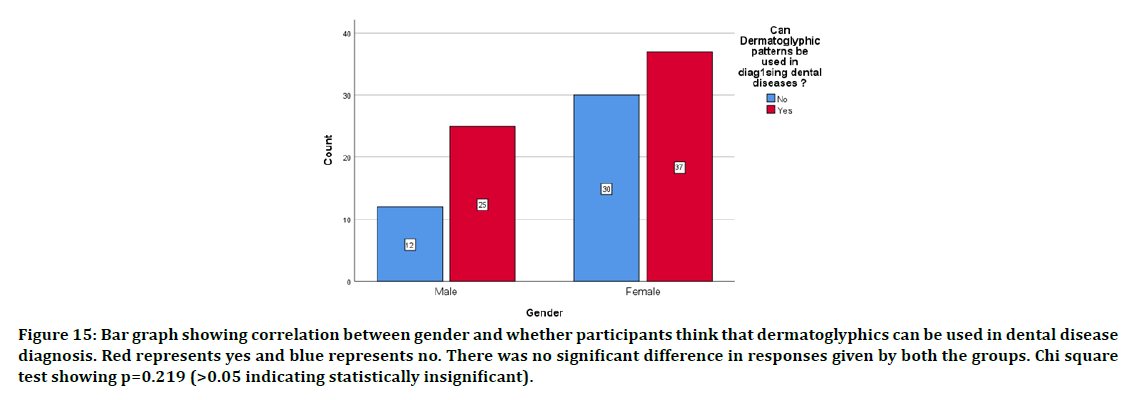
Figure 15: Bar graph showing correlation between gender and whether participants think that dermatoglyphics can be used in dental disease diagnosis. Red represents yes and blue represents no. There was no significant difference in responses given by both the groups. Chi square test showing p=0.219 (>0.05 indicating statistically insignificant).
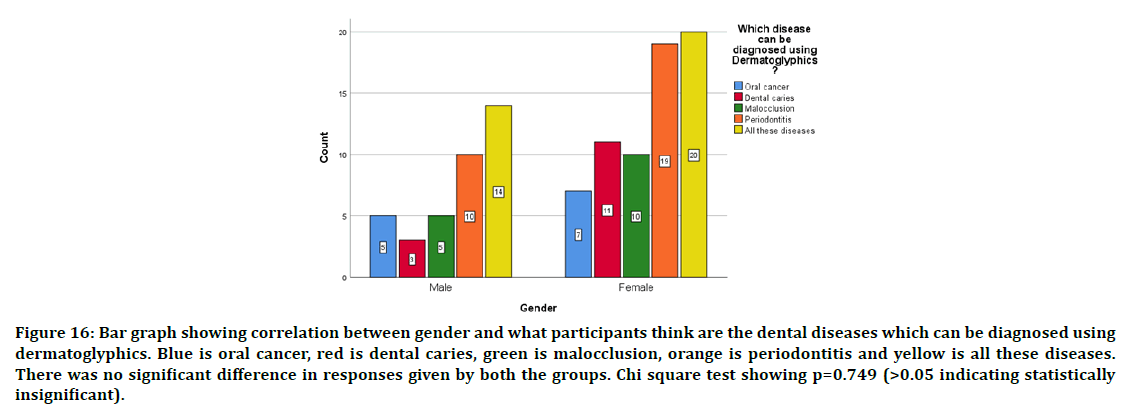
Figure 16: Bar graph showing correlation between gender and what participants think are the dental diseases which can be diagnosed using dermatoglyphics. Blue is oral cancer, red is dental caries, green is malocclusion, orange is periodontitis and yellow is all these diseases. There was no significant difference in responses given by both the groups. Chi square test showing p=0.749 (>0.05 indicating statistically insignificant).
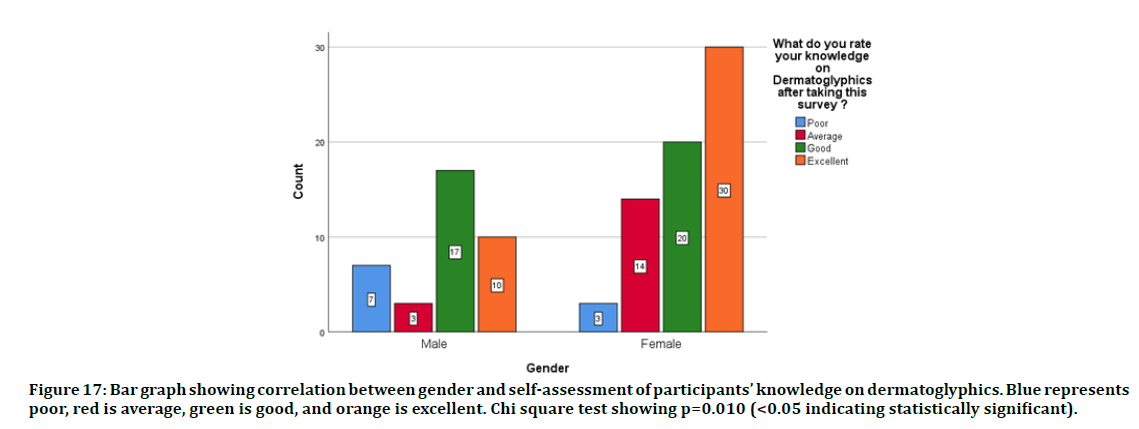
Figure 17: Bar graph showing correlation between gender and self-assessment of participants’ knowledge on dermatoglyphics. Blue represents poor, red is average, green is good, and orange is excellent. Chi square test showing p=0.010 (<0.05 indicating statistically significant).
Dermatoglyphics is an amazingly effective screening test which can be used in the early treatment/ diagnosis of many diseases [25,26]. This will aid in early correction and increase treatment options. It is of great clinical importance. However, the limitations of this survey include less sampling size, less criteria for assessment of knowledge and lack of assessment of practicality. Overcoming these may give us a better idea on awareness and knowledge of dermatoglyphics among first yeart BDS students. According to this survey, the knowledge was overall found to be poor.
Conclusion
After conducting and analysing the survey results, it may be concluded that the awareness and knowledge about dermatoglyphics among 1st year BDS students is between poor to moderate. There is definitely a need to create awareness on dermatoglyphics so that the future, budding dentists are aware about this diagnostic marvel.
References
- Prabhu N, Issrani R, Mathur S, et al. Dermatoglyphics in health and oral diseases-A review. JSM Dent 2014; 2:1044.
- Ashok V, Suvitha S. Awareness of all ceramic restoration in rural populations. Res J Pharm Tech 2016; 9:1691–1693.
- http://www.journalbji.com/index.php/BJI/article/view/2345
- Ashok V, Nallaswamy D, Benazir Begum S, et al. Lip bumper prosthesis for an acromegaly patient: A clinical report. J Indian Prosthodont Soc 2014; 14:279–282.
- Veeresh T, Mujahid A, Deepu P, et al. Correlation between dermatoglyphics, dental caries and salivary pH: An invivo study. Ethiop J Health Sci 2019; 29:929–934.
- Ranganathan H, Ganapathy DM, Jain AR, et al. Cervical and incisal marginal discrepancy in ceramic laminate veneering materials: A SEM Analysis. Contemp Clin Dent 2017; 8:272–278.
- Bulagouda RS, Patil PJ, Hadimani GA, et al. Study of palmar dermatoglyphics in patients with essential hypertension between the age group of 20–50 years. Int J Med Res Health Sci 2013; 2:773–779.
- Vijayalakshmi B, Ganapathy D. Medical management of cellulitis. Res J Pharm Technol 2016; 9:2067–2070.
- Baswaraj H, Lalakiya H, Mashru K, et al. Dermatoglyphics and malocclusion. J Int Oral Health 2016; 8:865.
- Kannan A. Effect of coated surfaces influencing screw loosening in implants: A systematic review and meta-analysis. WORLD 2017; 8:496–502.
- Charles A, Ramani P, Sherlin HJ, et al. Evaluation of dermatoglyphic patterns using digital scanner technique in skeletal malocclusion: A descriptive study. Indian J Dent Res 2018; 29:711–715.
- Sharma A, Kapoor D. Dermatoglyphics, dentistry and diagnosis-A review. Baba Farid University Dent J 2010; 1:45–48.
- Subasree S, Murthykumar K. Effect of aloe vera in oral health-A review. Res J Pharm Tech 2016; 9:609–612.
- Chandrasekaran S, Chellammal R, Ganapathy DM, et al. Dermatoglyphics: A tool in dentistry. J Adv Pharm Educ 2017; 7.
- Selvan SR, Ganapathy D. Efficacy of fifth generation cephalosporins against methicillin-resistant Staphylococcus aureus-A review. Res J Pharm Technol 2016; 9:1815–1818.
- Kannan A, Venugopalan S. A systematic review on the effect of use of impregnated retraction cords on gingiva. Research J Pharm and Tech 2018; 11:2121–2126.
- http://www.ijars.net/article_fulltext.asp?issn=0973-709x&year=2020&month=January&volume=9&issue=1&page=AO01-AO03&id=2521
- Ganapathy D, Sathyamoorthy A, Ranganathan H, et al. Effect of resin bonded luting agents influencing marginal discrepancy in all ceramic complete veneer crowns. J Clin Diagn Res 2016; 10:ZC67–70.
- Mathew L, Hegde AM, Rai K, et al. Dermatoglyphic peculiarities in children with oral clefts. J Indian Soc Pedod Prev Dent 2005; 23:179–182.
- Duraisamy R, Krishnan CS, Ramasubramanian H, et al. Compatibility of nonoriginal abutments with implants: Evaluation of microgap at the implant–abutment interface, with original and nonoriginal abutments. Implant Dent 2019; 28:289.
- Jain AR, Nallaswamy D, Ariga P, et al. Determination of correlation of width of maxillary anterior teeth using extraoral and intraoral factors in Indian population: A systematic review. World J Dent 2018; 9:68–75.
- Venugopalan S, Ariga P, Aggarwal P, et al. Case report: Magnetically retained silicone facial prosthesis. Niger J Clin Pract 2014; 17:260–264.
- Grace US, Sankari M. Dermatoglyphics--An indicator for periodontal disease? A cross-sectional study. Res J Pharm Tech 2019; 12:4349–4352.
- Jyothi S, Robin PK, Ganapathy D, et al. Periodontal health status of three different groups wearing temporary partial denture. Research J Pharm and Tech 2017; 10:4339–4342.
- Ajay R, Suma K, Ali SA, et al. Effect of surface modifications on the retention of cement-retained implant crowns under fatigue loads: An in vitro study. J Pharm Bioallied Sci 2017; 9:S154–160.
- Basha FYS, Ganapathy D, Venugopalan S, et al. Oral hygiene status among pregnant women. Research J Pharm Tech 2018; 11:3099–3102.
Author Info
Yoshita Guntupalli1, Keerthi Sasanka L1*, Karthik Ganesh Mohanraj2 and Dhanraj Ganapathy1
1Department of Pedodontics and Preventive Dentistry, Saveetha Dental College, Saveetha Institute of Medical and Technical Sciences, Saveetha University, Chennai, India2Department of Anatomy, Saveetha Dental College, Saveetha Institute of Medical and Technical Sciences, Saveetha University, Chennai, India
Citation: Yoshita Guntupalli, Keerthi SasankaL, Karthik Ganesh Mohanraj, Dhanraj Ganapathy, Dermatoglyphics in Dentistry a Study on Knowledge about Importance of Dermatoglyphics among First Year Dental Students, J Res Med Dent Sci, 2020, 8 (7): 234-239.
Received: 27-Sep-2020 Accepted: 28-Oct-2020 Published: 04-Nov-2020
